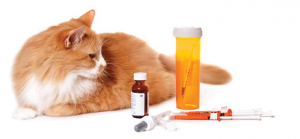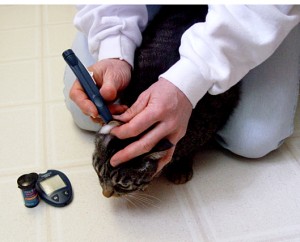
Diabetes In Our Feline Friends
Courtesy of: Dr. Michelle
Did you know that as many as one out of every 50 cats will develop diabetes in its lifetime? We tend to see this disease in obese cats that are between 10-13 years old. 70-80% of cats affected by the disease are male! This blog is intended to teach you what to watch for if you think your cat may be developing this disease, how we diagnose it, and how it is treated.
There are two types of diabetes mellitus (DM). Type 1, also known as insulin-dependent DM, occurs when the body destroys insulin secreting cells that are found in the pancreas. We rarely see this type in cats, but it is very common in dogs. Type 2, non-insulin dependent DM, occurs when insulin is still being made by the pancreas but not enough is being excreted. 80% of cats with DM have type 2. Obese cats are 4 times more likely to develop diabetes.
The main function of insulin is to promote storage of glucose in the body into its energy form, glycogen. It also allows amino acids to be stored as protein, and fatty acids to be stored as fat. In DM, storage does not occur and the kidneys are then unable to deal with the extra glucose in the body and it is excreted into the urine. The extra glucose in the urine causes an excessive amount of urination, followed by an excessive amount of drinking. Since there is a decreased amount of protein being made, animals with diabetes tend to lose weight and muscle mass. Therefore, early signs of DM that you may notice in your cats are: an increase in the amount and frequency they need to go out to urinate, an increase in the amount they want to eat, and weight loss. Other signs to watch for are lethargy, a poor hair coat, dehydration (despite the increase in drinking), and hind limb weakness.
We diagnose diabetes with a blood test to check for an elevated glucose level. Sometimes, when cats are stressed (especially after a car ride to the vet!), the glucose can look artificially elevated on the bloodwork. If a cat’s blood glucose level reads in this zone, we send the cat’s blood to an external laboratory to check another level called fructosamine. Fructosamine levels can accurately predict what the glucose level has been in the cat over the past two weeks. It removes the guesswork and will rule in or rule out diabetes.
Cats who are diagnosed with DM often have other diseases at the same time. The most common is a urinary tract infection. Often times, after your cat is diagnosed with DM, we will culture the urine sample to check for bacteria. Pancreatitis (inflammation of the pancreas- an organ near the liver) can also be seen with diabetes because insulin is produced in cells within the pancreas.
The main goal in treating diabetes is to resolve the clinical signs that the cat is showing, and to normalize the glucose level. We treat DM with insulin, which is injected with a very small needle under the cat’s skin. Usually these injections are needed every 12 to 24 hours. In cats (unlike in dogs), diabetes can go into remission after 1-4 months of insulin therapy. In addition to insulin, with weight loss and a diet change, we can also achieve remission, when the cat’s symptoms resolve completely. A high protein and low carbohydrate diet is needed in cats with DM. Higher protein levels will prevent muscle mass loss and will increase the metabolic rate of the cat. Low carbohydrate diets will decrease the insulin demand on tissues. Canned foods are lower in carbs than dry diets, and are often recommended in cats with DM.
After we diagnose your cat with diabetes, we may need to do several “glucose curves” during the first few months after diagnosis. This involves leaving your cat in the clinic for about 12 hours. We check the cat’s glucose level every 2 hours so that we can see how high and how low the glucose level goes in a day. Depending on the results, we may change the dose of insulin you are giving and recheck the curve in one week. Once we find an appropriate level of insulin to dose with, we recommend doing a glucose curve every few months, or you can be taught to check your cat’s glucose levels at home.
As mentioned above, cats with diabetes can go into remission. Things to watch for at home are a change in behavior or severe lethargy, a decreased willingness to play, or weight loss/gain. These changes happen because the glucose level remains too low when insulin is given and is no longer required. The cats may stay in remission as long as they are maintained on their special diet. Occasionally, a cat may come out of remission and insulin injections are once again required. Rarely, we may not be able to control your cat’s diabetes easily with insulin injections. Additional testing and treatments may be needed in those cases.
If you think your cat may be showing signs of diabetes, please give us a call at 893-2341 so we can schedule an appointment.



0 Comments